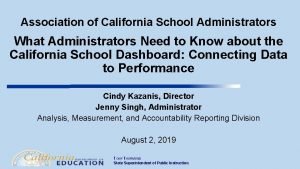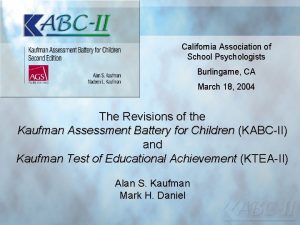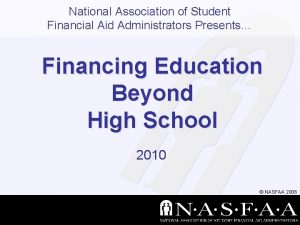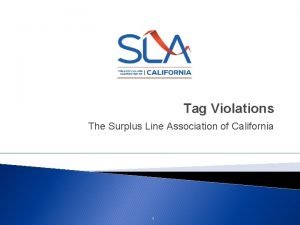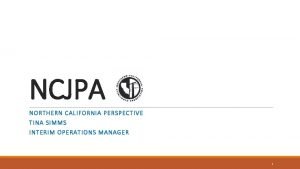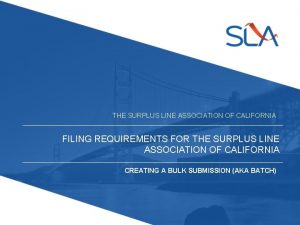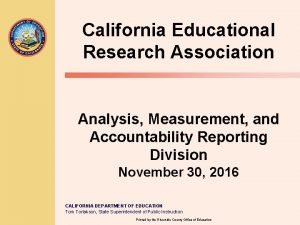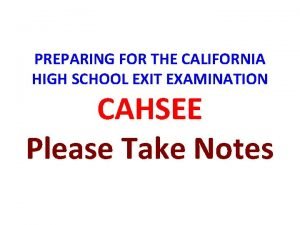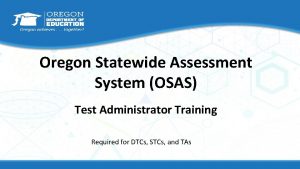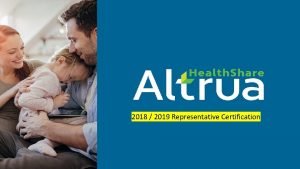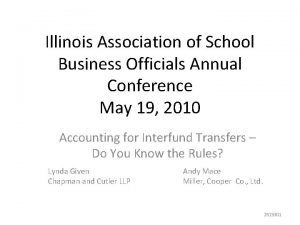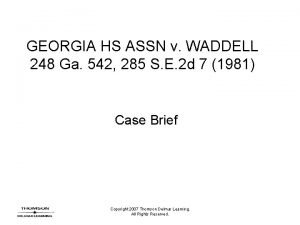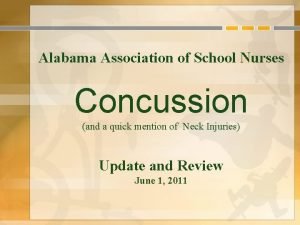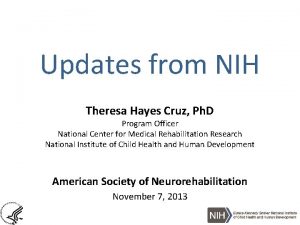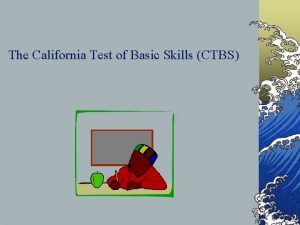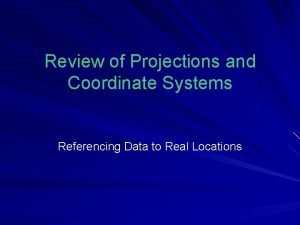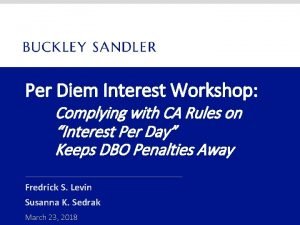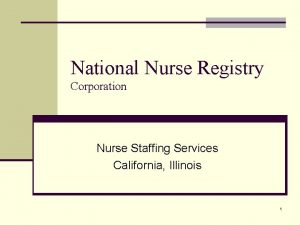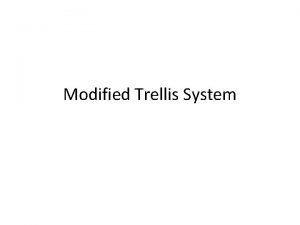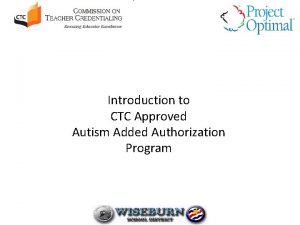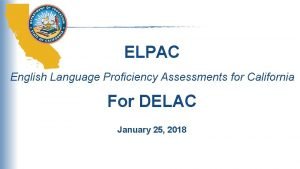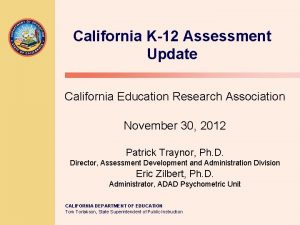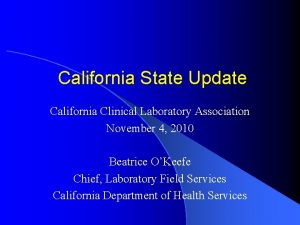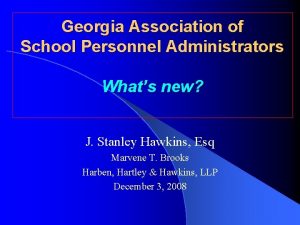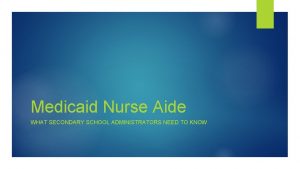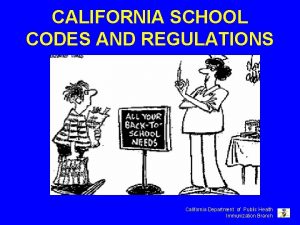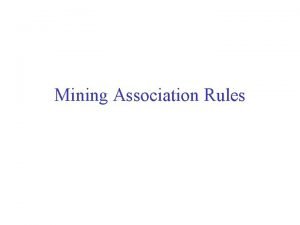Association of California School Administrators What Administrators Need















































































- Slides: 79

Association of California School Administrators What Administrators Need to Know about the California School Dashboard: Connecting Data to Performance Cindy Kazanis, Director Jenny Singh, Administrator Analysis, Measurement, and Accountability Reporting Division August 2, 2019 TONY THURMOND State Superintendent of Public Instruction

Topics • California School Dashboard (Dashboard) Mobile App • Dashboard Purpose • Overview and Update of State and Local Indicators • Connections to California Longitudinal Pupil Achievement Data System (CALPADS): Data Used for State Indicators Demographic Data for Student Groups California Department of Education 2

Dashboard Mobile App is now Available! Wherever you are, access to the Dashboard in English or Spanish is a simple swipe away! • District and School Reports at your fingertips. • Search for schools/districts on the go. • View performance levels of each state indicator. • Even drill-down to the performance details for student groups. • Available for i. OS and Android Devices • Download today at https: //www. cde. ca. gov/re/mo/cadashboard. asp. • i. OS Devices requires i. OS 12. 0 or later. (Compatible with i. Phone). • Android Devices requires Android Version 5. 0 (Lollipop) and up. 3

Dashboard Purpose California Department of Education 4

Purpose • Supports local educational agencies (LEAs) and schools by providing information on specific indicators to identify strengths, weaknesses, and areas needing improvement – In-depth analyses on specific areas can be conducted using local data • Reports data for all student groups to ensure that each student group is provided the attention and services they need • Promotes continuous improvement – Standards established to help schools make significant progress California Department of Education 5

Use of the Indicator Data • LEAs are required to use the data to inform their local control and accountability plans (LCAPs) • Schools are encouraged to use the data to inform their School Plan for Student Achievement • The state uses both local and state indicators to identify LEAs that are eligible for support and uses state indicators to identify schools that are eligible for support. The goal is to focus on how to improve outcomes for students. California Department of Education 6

Goal of a Strong Accountability System • A strong accountability system should: – Identify measures that impact student success during their K-12 experience and impacts their success after graduating high school – Encourage LEAs and schools to use the data to leverage change that improves student outcomes. California Department of Education 7

Overview and Update of State and Local Indicators California Department of Education 8

Local Indicators Basics: Teachers, Instructional Materials, Facilities Implementation of Academic Standards Parent Engagement Local Climate Survey Access to a Broad Course of Study • LEAs are responsible for uploading information on local indicators in the Dashboard. California Department of Education 9

Local Indicators: How Do You Get a Rating? • LEAs determine whether they have: – Met – Not Met for More than Two Years • Based on whether they completed the following requirements: – Annually measure progress on local performance indicator based on locally available data – Report results at a regularly scheduled public meeting of the local governing board – Report results to the public through the Dashboard California Department of Education 10

State Indicators by Grade Span State Indicator Chronic Absenteeism Indicator Suspension Rate Indicator Graduation Rate Indicator College/Career Indicator (CCI) Academic Indicator English Learner Progress Indicator • Not reported in 2018 Dashboard • Status only reported in 2019 Dashboard California Department of Education Grade Span K– 8 K– 12 9– 12 3– 8 and 11 1– 12 11

Core Rule Used Throughout the Dashboard • For all state indicators, the data are based on data generated at your LEA or school – You don’t inherit another LEA’s or school’s data! – When students transfer, the data that students generated at your LEA or school does not impact the data of the new LEA and/or school • For example: Jason was suspended at your school three times and then transfers to Moonlight School. The three suspensions do not follow Jason to Moonlight. California Department of Education 12

N-Size Requirements for State Indicators • LEAs, schools, and student groups receive performance levels (or colors) for each state indicator with at least 30 students in the current and prior year – “ 30 or more” determination differs for each state indicator • Exception: LEAs receive a color for homeless and foster youth if they have at least 15 students in the current and prior year. – Note: Charter schools are treated as schools (not LEAs) for reporting these two student groups (i. e. , need at least 30 or more students in these two student groups to received a performance color). California Department of Education 13

Small Student Populations • Small student populations are more susceptible to large swings in results from year to year • Therefore, a three-by-five table (condensed from a five-by-five table) is applied used when N size is less than 150 at the LEA, schools and student group levels • N size is based on different denominators, depending on the state indicator 14

N Size for Small Student Populations • Graduation Rate Indicator: N = number of students in the four- and five-year combined graduation rate or the DASS graduation rate • Suspension Rate Indicator: N = number of students cumulatively enrolled • Chronic Absenteeism Rate Indicator: N = number of students who meet the enrollment eligibility • CCI: N = number of students in the four- and five-year combined graduation rate or the DASS graduation rate California Department of Education 15

Do Alternative Schools Get a Dashboard Too? • Yes. All alternative schools, or schools with Dashboard Alternative School Status (DASS), receive a Dashboard. – DASS schools held accountable for all state indicators currently reported in the Dashboard. – However, “modified methods” are used for select state indicators to fairly evaluate the success and progress of alternative schools that serve high-risk students. California Department of Education 16

Modified Methods for DASS Schools • Modified graduation rate was approved by the State Board of Education (SBE) • New career measures for the CCI, specifically targeting DASS schools, are being collected in 2018 -19 • New Status level cut scores for the Academic Indicator will be proposed to the SBE in September 2019 California Department of Education 17

Chronic Absenteeism California Department of Education 18

Chronic Absenteeism Indicator: Grades K-8 • No changes for 2019 Dashboard • Students are removed from the calculation if they were: Enrolled less than 31 instructional days Enrolled at least 31 instructional days but did not attend at least one day (different from Data. Quest reporting rules), and Flagged as exempt in the district attendance submission o Enrolled in a Non-Public School (NPS) o Received instruction through a home or hospital instructional setting, or o Attended community college full-time. California Department of Education 19

LEA Concerns • Indicator includes kindergarten students Research shows that chronic absenteeism in kindergarten impacts achievement in later years • Indicator includes medically fragile students – California Department of Education (CDE) will be convening a work group to develop a definition for medically fragile to be used for accountability purposes § Students who meet this definition will be excluded from the chronic absenteeism indicator, when approved by the SBE California Department of Education 20

Automatic Assignment of Orange • LEAs and schools are automatically assigned an Orange performance level if they do not certify (or submit) their attendance data in CALPADS for the current or prior Dashboard cycles. California Department of Education 21

Status and Change for 2019 Dashboard Status: Percent of students who were absent 10 percent or more of instructional days in 2018 -19 Change: 2019 chronic absenteeism rates minus 2018 chronic absenteeism rates California Department of Education 22

Suspension Rate California Department of Education 23

Suspension Rate Indicator: Grades K– 12 • No changes for 2019 Dashboard • Indicator is based on count of students who were suspended CALPADS cumulative enrollment data are used California Department of Education 24

Definition of Cumulative Enrollment • Total number of students who, at any time during the school year, enrolled in a school. ØExample: A student who enrolls in a school on March 7, is suspended on March 8, and transfers out on March 15 would be counted in the school’s cumulative enrollment and the school’s suspension rate. California Department of Education 25

Defining Suspension • Multiple Suspensions for One Student: A student who is suspended multiple times is only counted as suspended once. • Both “in-school” and “out-of-school” suspensions are counted in the numerator of the suspension rate calculation. • “In-School” Suspensions: – Defined as when principal or principal designee assigns a student to a supervised suspension classroom California Department of Education 26

Suspensions do not include…. • Reassignment to another education program or class at the same school where the pupil will receive ongoing instruction, • Referral to a certificated employee designated by the principal to advise pupils, or • Removal from the class, but without reassignment to another class or program, for the remainder of the class period without sending the pupil to the principal or the principal’s designee California Department of Education 27

Discipline Data Business Rule Changes (See CALPADS Flash #145 – November 2018) • Due to federal reporting requirements, beginning in 2018 -19, LEAs must report, in CALPADS, all increments of suspension for all students, including students with disabilities (SWDs): – Before: Report suspensions in any increments of a day for SWDs and only full-day suspensions for all other students – Now: Report all suspensions, regardless of the length of suspension § Dashboard will only include students cumulatively suspended for a full day (i. e. , students suspended for less than a day will be excluded) California Department of Education 28

Automatic Assignment of Orange for Suspension • LEAs and schools are automatically assigned an Orange performance level if they do not certify (or submit) their discipline data in CALPADS for the current or prior Dashboard cycles. California Department of Education 29

Suspension Rate: Status and Change for 2019 Dashboard Status: 2019 Suspension Rates Change: 2019 Suspension Rates minus 2018 Suspension Rates California Department of Education 30

Separate Set of Cut Scores • Because suspension data vary widely by LEA and school type, cut scores were set separately. This resulted in six different sets of cut scores: – Three sets based on LEA type – Three sets based on school type • To access cut scores for all state indicators, see: – CDE Five-by-Five Colored Tables web page at: https: //www. cde. ca. gov/ta/ac/cm/fivebyfivecolortables 18. asp California Department of Education 31

Any Questions? 32

Graduation Rate California Department of Education 33

Graduation Rate Updates for 2019 Dashboard 1. Inclusion of a combined four-and five-year graduation rate for comprehensive high schools 2. Potential changes to Very Low and Low Status cut scores: – To be presented at September 2019 SBE meeting – No revisions to Change cut scores California Department of Education 34

Combined Four- and Five-Year Graduation Rate • In July 2019, the SBE adopted a combined four- and fiveyear graduation rate for the Graduation Rate Indicator. – Reflects students who graduate in a given year – Example: All 2018 four- and five-year graduates: § Based on Class of 2018 cohort with addition of fifth year graduates from Class of 2017 California Department of Education 35

Example of Combining Four-and-Five Year Graduates • For the Class of 2018, there were 95 graduates out of 100 students in the four-year cohort for a rate of 95 percent. • For the Class of 2017, five students graduated in their fifth year (i. e. , five-year cohort). • The combined graduation rate is: (95 + 5)/(100 + 5)= 95. 2 percent CALIFORNIA DEPARTMENT OF EDUCATION 36

DASS High Schools • The combined rate applies only to non-alternative (non-DASS) high schools • The DASS graduation rate, which is based on grade twelve students, already includes students who graduate in: – Four-years, – Five-years, – Six years, or more California Department of Education 37

Student Transfers • When students transfer—the last school where a student is enrolled is held accountable for the students graduation status. – Rule applies to both non-DASS and DASS high schools California Department of Education 38

Who Counts as Graduates in the Combined Rate? • Only students who earn a standard diploma are counted as graduates. Graduates do not include students who earn: A certificate of completion High School Equivalency certificate (i. e. , GED, Hi. SET, and TASC*) Adult education diploma California High School Proficiency Exam *GED: General Educational Development; Hi. SET: High School Equivalency Test; TASC: Test Assessing Secondary Completion California Department of Education 39

Status and Change for 2019 Dashboard for Comprehensive High Schools • • California Department of Education 40

DASS Graduation Rate California Department of Education 41

DASS Graduation Rate: Based on Grade 12 Students • The four-year cohort graduation rate is used for non-DASS schools. – This measurement is not appropriate to use to evaluate DASS schools who serve highly mobile and credit deficient students. • The SBE approved using a grade 12 graduation rate for all DASS schools (e. g. , continuation school, juvenile court schools, community day, etc. ). California Department of Education 42

Four-Year vs. DASS Graduation Rate Students who are counted as graduates differ: 4 -Year Cohort Graduation Rate DASS Grade 12 Graduation Rate (Used for Graduation Rate Indicator) (Modified Method) • Standard diploma • • • Standard diploma High School Equivalency certificate (i. e. , GED, Hi. SET, and TASC*) Adult education diploma (issued by DASS schools) Early graduates (grade eleven students) California High School Proficiency Exam (CHSPE) Special Education Certificate of Completion (must be eligible to take the California Alternate Assessments) *GED: General Educational Development; Hi. SET: High School Equivalency Test; TASC: Test Assessing Secondary Completion California Department of Education 43

New Transition Status Field • Participation in a transition program are now collected in CALPADS: – File: Student Enrollment (SENR) – Field: Postsecondary/Transition Status Indicator • To populate this field, a student must be 17 years or older, have a grade level of 12, and have a Special Education program record. • This indicator should not be set to “Y” until AFTER the student’s initial cohort graduation year • Student participating in a transition program will be removed from both the numerator and denominator of the DASS graduation rate. California Department of Education 44

Proposed Updates to Status Levels • Since combined rate increases graduation rates, SBE has determined that the State should raise the Very Low Status level threshold • To date, Very Low level set at less than 67 percent – Schools with graduation rates below 67 percent were eligible for comprehensive support and improvement (CSI) under ESSA • Two new thresholds— 68 percent and 70 percent—proposed for consideration – Adopting new threshold will result in revised Status cut scores for Very Low and Low levels for all schools (i. e. , DASS and non. DASS) California Department of Education 45

Questions Related to the Suspension Rate or Chronic Absenteeism Rate Indicators? 46

College/Career Indicator (CCI) California Department of Education 47

CCI: Grades 9 -12 • Based on graduation cohort: – For non-DASS schools, the four-and five-year combined graduation rate is used – For DASS schools, the students in the DASS graduation rate are included • Includes all students, including those who take the CAAs • Contains both college and career measures and allows for fair comparisons across all districts and schools that serve high school students. • Multiple ways for students to be considered “Prepared” – Students not required to meet all measures California Department of Education 48

CCI Levels • Three performance levels for the CCI: ØPrepared ØApproaching Prepared ØNot Prepared • See CCI flyer for the criteria for each level (https: //www. cde. ca. gov/ta/ac/cm/documents/collegecare erready 18. pdf) California Department of Education 49

Current CCI Measures International Baccalaureate (IB) Exams Grade 11 Smarter Balanced Summative Assessments College Credit Course (Previously referenced as dual enrollment) a-g Completion Advanced Placement (AP) Exams Career Technical Education (CTE) Pathway completion State Seal of Biliteracy Leadership/Military Science California Department of Education 50

Years of Data Used For all schools (non-DASS and DASS): • Students Graduating in Four Years – Most recent four-years of coursework and exams are used to place students in Prepared or Approaching Prepared levels • Students Graduating in Five Years – Most recent five-years of coursework and exams are used to place students in Prepared or Approaching Prepared levels California Department of Education 51

LEA Concerns • Articulated CTE capstone courses (articulated agreement between the high school and community college) are not counted for both college credit and completion of CTE pathway • Analysis conducted by comparing student’s performance on the summative ELA assessment between those who took an articulate CTE course and those who did not – Results showed that articulation makes little difference on assessment performance § Students taking non-articulated CTE courses fared slightly better California Department of Education 52

CCI: Status and Change for 2019 Dashboard Status: Percent of Prepared Students in the Class of 2019 Change: Difference in the Percent of Prepared Students Between Class of 2019 and Class of 2018 California Department of Education 53

Career Measures Collected in 2018– 19 Completion of Pre. Apprenticeship* (both DASS and Non. DASS Schools) Completion of a State or Federal Job Program* (limited to DASS schools) Work Force Readiness Certificate* Food Handler Certification* (limited to DASS schools - potential use by Juvenile Court schools) Completion of Workability Courses & Work-Based Learning** Completion of DOR Work-Based Learning** (limited to students with IEP) IEP=Individualized Education Program; DOR=Department of Rehabilitation * Measures collected in CALPADS. ** Measures collected in CASEMIS for 2018 -19 only. These measures will be collected in CALPADS in 2019 -20. California Department of Education 54

Deadlines and Additional Information • Measures collected in CALPADS – Collection deadline in CALPADS: August 30, 2019 – While they will not be included until 2020 Dashboard, CDE will begin reviewing the data this year with stakeholders and LEAs to make initial decisions • Measures collected in CASEMIS – Collection deadline in CASEMIS: August 9, 2019 – Could potentially be included in the 2019 Dashboard • Definitions of each measure, including guidance: – See CALPADS Flashes #137, #156, and #157 – See 2018 Dashboard Technical Guide (Tables 11 and 12) California Department of Education 55

Career Measures Proposed for Collection in the 2020– 21 School Year Student Owned Business Hours Count (both DASS and Non. DASS schools) Internship Hours Count (both DASS and Non. DASS schools) • The CDE will be working with the CCI Work Group and other stakeholders to develop guidance that will be distributed to LEAs. 56

Questions Related to the Graduation Rate or CCI Indicators? 57

Academic Indicator California Department of Education 58

Academic Updates for 2019 Dashboard 1. Inclusion of the California Alternate Assessments (CAAs) in calculations for Distance from Standard (DFS) 2. New Status cut scores for DASS schools 3. Expansion in “district of residence” rule for students with disabilities (SWDs) California Department of Education 59

Academic Indicator: Grades 3– 8 and Grade 11 • Assessments: • Content Areas: Participation Rate English Language Arts Mathematics NOTE: California Science Test (CAST) is not used! o Smarter Balanced Summative Assessments (SBAC) o California Alternate Assessments (CAAs) DFS o SBAC o CAAs – proposed for September 2019 State Board meeting California Department of Education 60

Distance from Standard (DFS) • Calculates average distance between all student test scores and lowest possible scale score for the Standard Met Achievement Level (Level 3) for that grade level – Average DFS is calculated for each LEA, school, and student group. • Performance levels (colors) are based on DFS California Department of Education 61

DFS Example: Grade 5 Smarter Balanced Summative Assessments in Mathematics A Grade 5 student received a score of 2, 505. • Student scored 2, 505. This is 23 points below the lowest possible score for Level 3. The student’s DFS for mathematics is -23 points. • (2, 505 – 2, 528 = -23 points) California Department of Education 62

Proposal to Include the CAAs • To date, the DFS has been based on Smarter Balanced Summative Assessments only • U. S. Department of Education requires the incorporation of the CAAs in DFS – Three methodologies have been considered by the Technical Design Group (TDG) and other stakeholders – Methodologies and recommendation will be proposed to the SBE in September 2019 California Department of Education 63

Participation Rate Is Also a Factor • ESSA requires schools to have at least 95 percent of its students participate on the standardized assessments. – Therefore, if an LEA, school, or student group does not meet the 95 percent participation rate target, the percent of students needed to bring it to 95 percent will be factored into the DFS results. • The participation count includes students who take the Smarter Balanced Assessment and those who take the CAAs. California Department of Education 64

Separate Cut Scores by Grade Spans • To date, the SBE has approved cut scores based on district and school type for ELA and mathematics. Grades 3 -8 Cut Scores Elementary School Middle School K– 12 School Elementary School District Unified School District Grade 11 Cut Scores High School (serving grades 7– 12 ) High School District (blank) California Department of Education 65

Proposed Status Cut Scores for DASS Schools • Based on feedback from the California Alternative Schools Task Force, separate cut scores for DASS schools were reviewed. • In September 2019, the CDE will propose to the SBE separate Status cut scores for Very Low and Low levels only. – No revisions proposed for Change cut scores California Department of Education 66

Current District of Residence Rule • For Academic Indicator only, if a student receives services from a special education school (based on ownership code) at another district or a county office of education or from a Non-Public School (NPS), the assessment results are sent back to the District of Special Education Accountability (or the District of Residence) for inclusion in their Dashboard. – Business rule was used in former accountability systems (i. e. , API and AYP), including all Dashboard releases (i. e. , 2017 and 2018 Dashboards) • Assessment results are not included in the Dashboard of the LEA providing services California Department of Education 67

Proposed Changes for the 2019 Dashboard • Expand the rule – For the Academic Indicator only, the District of Special Education Accountability will be held accountable for all SWDs, not just those who receive services from a special education school or NPS school • This ensures that the LEA receiving federal IDEA funding for these students is held accountable for the outcomes of all SWDs. California Department of Education 68

Which Entity Is Accountable for SWDs for the Dashboard? State Indicator Academic Suspension Chronic Absenteeism Graduation Rate CCI ELPI School of Attendance District of Residence (District of Special Education Accountability) LEA of Attendance Responsible Responsible Not Responsible Responsible Not Responsible California Department of Education 69

Changes Beyond the 2019 Dashboard: Expand Rule to All State Indicators • The CDE is proposing to apply the District of Special Education Accountability rule to all the state indicators for the 2020 Dashboard to align with the transition from CASEMIS to CALPADS. Provides sufficient notice CALPADS=California Longitudinal Pupil Achievement Data System CASEMIS=California Special Education Management Information System California Department of Education 70

Automatic Assignment of Orange for Academic Indicator • LEAs and schools are automatically assigned an Orange performance level if they fail to test at least ten percent of their testing population. California Department of Education 71

Academic: Status and Change for 2019 Dashboard Status: Average DFS for All Students Who Took the 2019 Smarter Balanced Assessments or CAAs Change: 2019 Average DFS minus 2018 Average DFS • To calculate Change, the 2018 Average DFS will be re-calculated for the 2019 Dashboard to incorporate the new revisions California Department of Education 72

Questions Related to the Academic Indicator? 73

English Learner Progress Indicator (ELPI): Grades 1– 12 • Due to transition to the English Language Proficiency Assessments for California (ELPAC), the Department—with stakeholder input—has been reviewing the methodology used to determine EL progress toward proficiency for state and federal accountability purposes. • Current Timeline: Status only will be reported in the 2019 Dashboard – Cut scores for Status will be proposed at November 2019 SBE meeting California Department of Education 74

Demographic Data for Student Groups California Department of Education 75

Data Used for State Indicators • Majority of state indicators use data derived from CALPADS, including demographic data for student group determinations. • Therefore, it is important that LEAs meet the CALPADS certification timelines (August 30, 2019). Once the amendment windows close, there are no additional opportunities to correct the data for the Dashboard! California Department of Education 76

Program Participation Revisions • Beginning with the 2019 Dashboard state indicators based on annual data, students that participate in a program at any point during the academic year, at the school or LEA, will be included in the appropriate student group: – Foster Youth – Homeless – English Learner – Socioeconomically disadvantaged – Students with disabilities • For graduation rate and CCI, students are placed in one of the groups above if they participated in that program any time during their four or five years of high school. California Department of Education 77

Dashboard Resources California School Dashboard and Additional Reports and Data https: //www 6. cde. ca. gov/californiamodel/ System of Support https: //www. cde. ca. gov/ta/ac/cm/ • Parent Tab: o Parent Guide and Flyers • Resources Tab: o Webinar Power. Points • Toolkit Tab: o Dashboard: Key Points and Updates o Flyers for Educators • Data Files and Guide Tab: o Data Files for each indicator o Dashboard Technical Guide • FAQs Tab • • • 5 x 5 s for Each Indicator CCI Measures Report (new look!) Participation Rate Report Student Group Report District Performance by County DASS https: //www. cde. ca. gov/ta/ac/dass. asp • Current list, Background, and Eligibility Criteria • Application Instructions • Flyer: What is the DASS? • DASS Graduation Rate Power. Point California Department of Education 78

Thank You! State Indicators Local Indicators Academic Accountability Unit Local Agency Systems Support Office aau@cde. ca. gov lcff@cde. ca. gov 916 -319 -0863 CALPADS calpads@cde. ca. gov 916 -324 -6738 California Department of Education 79
 California association of school administrators
California association of school administrators Michigan association of administrators of special education
Michigan association of administrators of special education California association of school psychologists
California association of school psychologists California school library association
California school library association National association of hbcu title iii administrators
National association of hbcu title iii administrators Fneaa
Fneaa Missouri association of court administrators
Missouri association of court administrators National association of financial aid administrators
National association of financial aid administrators Michigan association of special education administrators
Michigan association of special education administrators National association of financial aid administrators
National association of financial aid administrators Surplus line association of california
Surplus line association of california Northern california joint pole association
Northern california joint pole association California surplus lines association
California surplus lines association California youth football association
California youth football association California association of independent schools
California association of independent schools California insurance wholesalers association
California insurance wholesalers association California central service association
California central service association California association for local economic development
California association for local economic development Power association of northern california
Power association of northern california California educational research association
California educational research association California high school exit examination
California high school exit examination I consider your behavior rude irresponsible and
I consider your behavior rude irresponsible and Osas portal .org
Osas portal .org Iste standards for administrators
Iste standards for administrators Smart goals for special education administrators
Smart goals for special education administrators He was treated like a ____ and cast out from his community.
He was treated like a ____ and cast out from his community. Crown healthshare administrators inc
Crown healthshare administrators inc Curriculum managers and administrators
Curriculum managers and administrators Dilignece
Dilignece Black public administrators
Black public administrators Crown healthshare administrators inc
Crown healthshare administrators inc International global assistance
International global assistance Crown healthshare administrators inc
Crown healthshare administrators inc Nchsaa handbook
Nchsaa handbook Montana officials association
Montana officials association Colorado association of school business officials
Colorado association of school business officials Texas school nurses organization
Texas school nurses organization Washington school counselor association
Washington school counselor association Utah school board association
Utah school board association Pennsylvania association of school business officials
Pennsylvania association of school business officials Florida high school athletic association basketball
Florida high school athletic association basketball Kgca golf
Kgca golf Illinois association of school business officials
Illinois association of school business officials Georgia high school association v. waddell
Georgia high school association v. waddell American school health association conference
American school health association conference Alabama high school athletic association eligibility rules
Alabama high school athletic association eligibility rules Virginia counselor association
Virginia counselor association South carolina association of school librarians
South carolina association of school librarians Texas high school bass fishing association
Texas high school bass fishing association National association of school resource officers
National association of school resource officers Missouri comprehensive guidance and counseling program
Missouri comprehensive guidance and counseling program Oregon association of school business officials
Oregon association of school business officials Mississippi association of school business officials
Mississippi association of school business officials Alabama association of school nurses
Alabama association of school nurses Can you lend larry and me that literary cavalcade
Can you lend larry and me that literary cavalcade Theresa cruz email
Theresa cruz email Lvn to bsn california
Lvn to bsn california Ctbs test
Ctbs test Preschool curriculum framework
Preschool curriculum framework Early care and education workforce registry
Early care and education workforce registry Bakke v california summary
Bakke v california summary Colitas definition hotel california
Colitas definition hotel california Seal of civic engagement
Seal of civic engagement Santa monica california
Santa monica california California state plane zones
California state plane zones California plate boundaries
California plate boundaries Pest control operators of california
Pest control operators of california California per diem interest disclosure
California per diem interest disclosure Patricia va a california chapter 6
Patricia va a california chapter 6 Ngss california
Ngss california Nurseregistry
Nurseregistry Smart dyson trellis
Smart dyson trellis California map to inclusion and belonging
California map to inclusion and belonging Maidu tribe of california
Maidu tribe of california California medical license for foreign medical graduates
California medical license for foreign medical graduates Autism authorization california
Autism authorization california Griffin v. california
Griffin v. california Bridging emerging expanding
Bridging emerging expanding Fair pay for northern california nonprofits
Fair pay for northern california nonprofits Elpac proficiency levels
Elpac proficiency levels
